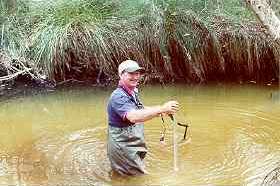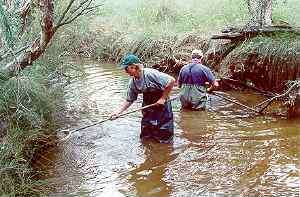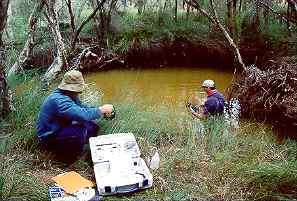
 |
Water Quality Monitoring in the Springs Catchment | August 2001 |
 |
| Tony Smith, spokesperson for the group, measuring turbidity at one of the six sites chosen to sample. The site is located on a creek on Tony's property. Turbidity is a measure of the concentration of suspended sediments in the water. High concentrations of suspended sediments may be the direct consequence of human activity in the catchment, such as earthworks, land clearing and erosion. |
Ribbons of Blue/Waterwatch WA Regional Coordinator for the south coast Kirsty Alexander provides support for community groups carrying out water quality monitoring activities within their catchment. The technical support provided to the group includes training in water quality monitoring techniques, how to interpret the data, and supply of equipment to carry out the monitoring program.
Land use in the Springs catchment has changed dramatically in the past decade. Sheep and cattle farming was once the dominant type of agriculture. This type of farming is being increasingly replaced by extensive viticulture, aquaculture and plantation forestry operations within the catchment. As a result, impacts on water quality in the region may also have changed. This is what the group wishes to find out.
 |
| Group members sampling for macroinvertebrates. At this site two species of native fish were also found, the night fish Bostockia porosa and the minnow Galaxias occidentalis |
The group has a very positive and progressive approach to land care in the catchment, and believes that all landholders in the catchment are neighbours, and thus should collaborate and cooperate as a group. To this end, farmers invited plantation companies to participate in the monitoring program. Several of the local plantation forestry companies now have representatives involved in the monitoring program, and one of the six sites being monitored by the group is located in a blue gum plantation.
The water quality monitoring program designed by the group will detect any changes in water quality and biodiversity within the catchment. A range of physical, chemical and biological parameters will be monitored at each of the six sites in the catchment on a regular basis. The group selected sites on streams which represent all land use types currently in the catchment, as well as one in a reserve which will serve as a reference site.
 |
| Tony Smith and Michael Jenkins sampling water for dissolved oxygen, temperature, pH and salinity. |
The group is also conducting stream restoration works within the catchment. One site was selected on the main road running through the catchment from Mt Barker to Denmark. The site will be used to increase the awareness and uptake of best management practices in stream restoration in the region. All procedures such as fencing, weed control, site preparation, revegetation and water quality monitoring will be documented, and can be used as a valuable reference in future restoration works which are planned in the catchment.
Depopulation of rural areas is a growing problem in Australia, and the Springs catchment is no exception, as landholders such as vineyard owners and plantation forestry companies often do not live in the catchment. The Ribbons of Blue/Waterwatch WA monitoring program in the Springs sub-catchment has the added benefit of encouraging social interaction between landholders within the catchment. The group always end a monitoring day with a social event such as a barbecue!
 |
| Springs subcatchment group preparing sampling equipment at one of the sites prior to monitoring |